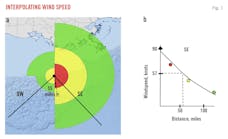Study concludes hydraulic fracturing poses low earthquake risk
Hydraulic fracturing has a low risk for inducing earthquakes that can be felt by people but underground injection of wastewater produced by fracing and other energy technologies has a higher risk of causing earthquakes, the National Research Council said in a report released June 15.
Carbon capture and storage may have the potential for inducing seismic events because significant volumes of fluids are injected underground over long periods of time, the report said, but insufficient information exists to understand the potential earthquake risk related to CCS.
The committee writing the report said continued research is needed to examine potential for induced seismic events in large-scale CCS projects. The US Department of Energy sponsored the report after a June 2010 congressional request for such a study.
The report examined the potential for shale gas recovery, CCS, geothermal energy production, and conventional oil and gas development to cause earthquakes. Fracing as currently used for shale gas recovery does not pose a high risk for inducing felt seismic events, the study said.
The committee noted the number of incidents have been “very few” given the thousands of wells in which fracing has been used across the US.
“While scientists understand the general mechanisms that induce seismic events, they are unable to accurately predict the magnitude or occurrence of these earthquakes due to insufficient information about the natural rock systems and a lack of validated predictive models at specific energy development sites,” the report said.
The factor most directly correlated with induced earthquakes is the total balance of fluid introduced or removed underground, the committee said.
Because oil and gas development, CCS, and geothermal energy production each involve net fluid injection or withdrawal, all have at least the potential to induce earthquakes that could be felt by people.
Technologies designed to maintain a balance between the amounts of fluid being injected and withdrawn, such as most geothermal and conventional oil and gas development, appear to produce fewer induced seismic events than technologies that do not maintain fluid balance.
Numerous federal and state agencies have regulatory oversight related to different aspects of underground injection activities associated with energy technologies. The committee issuing the report said interagency cooperation is warranted given expanding energy development.
Seismic events caused by or likely related to energy development have been measured and felt in Alabama, Arkansas, California, Colorado, Illinois, Louisiana, Mississippi, Nebraska, Nevada, New Mexico, Ohio, Oklahoma, and Texas, the report said.
Abroad, the UK government has looked into events around a Cuadrilla Resources Ltd. shale-gas well near Poulton-le-Fylde (OGJ Online, Nov. 3, 2011).
Cuadrilla commissioned the study that found a high probability that hydraulic fracturing of its Preese Hall-1 well triggered seismic events. The well was completed in a Bowland basin shale, which Cuadrilla has said might hold 200 tcf of natural gas in place in its 437-sq-mile license area between Blackpool and Preston (OGJ Online, Sept. 22, 2011).
Contact Paula Dittrick at [email protected].

Paula Dittrick | Senior Staff Writer
Paula Dittrick has covered oil and gas from Houston for more than 20 years. Starting in May 2007, she developed a health, safety, and environment beat for Oil & Gas Journal. Dittrick is familiar with the industry’s financial aspects. She also monitors issues associated with carbon sequestration and renewable energy.
Dittrick joined OGJ in February 2001. Previously, she worked for Dow Jones and United Press International. She began writing about oil and gas as UPI’s West Texas bureau chief during the 1980s. She earned a Bachelor’s of Science degree in journalism from the University of Nebraska in 1974.

